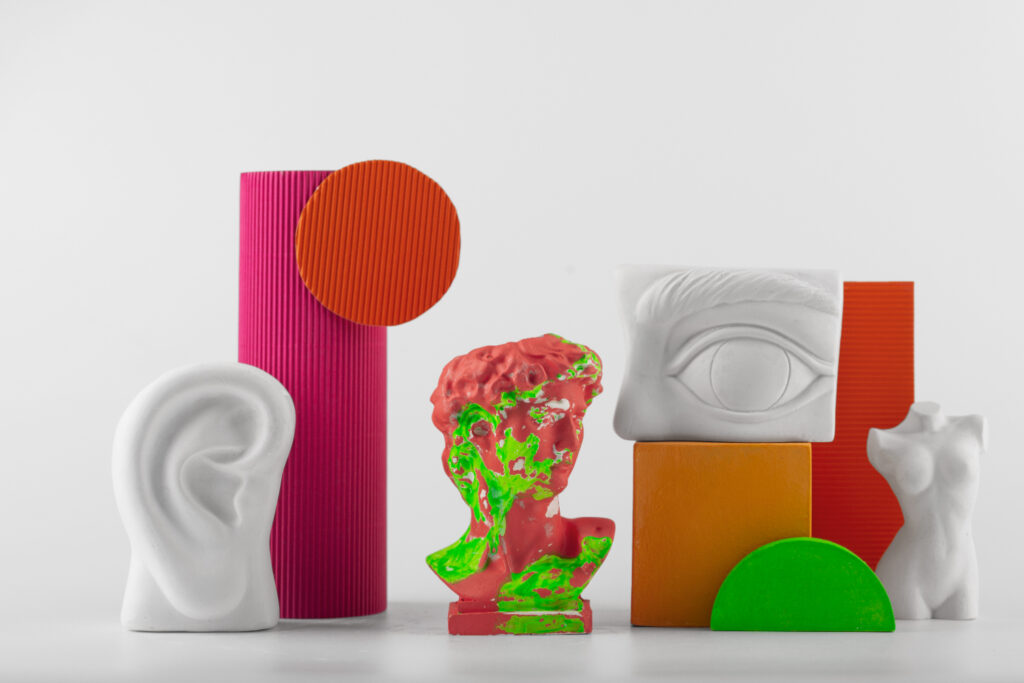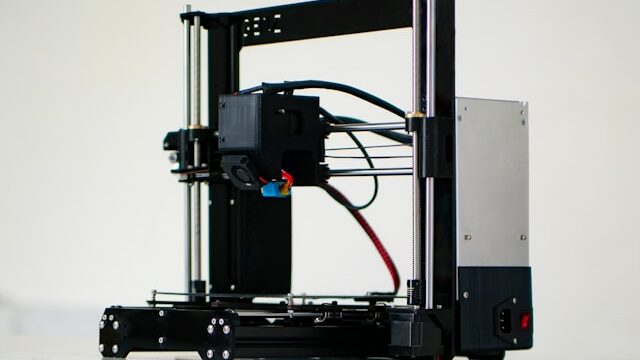Do you want to print or have faces 3D printed but don’t know where to start? You can easily do it by reaching out to Imprimy or exploring the content of this article.
3D printing of faces allows the creation of realistic and customized replicas from scans or digital models.

What is 3D printing of faces?
3D printing of faces is a technique that uses 3D printers to create physical models from digital data, allowing for the precise reproduction of facial features.
The definition of 3D printing applied to faces
3D printing applied to faces is a technological process that allows the creation of three-dimensional physical models from digital data. This technique uses specialized printers that deposit materials such as plastic, resin, or even biomaterials layer by layer to accurately reproduce facial features.
The application of 3D printing in this field is particularly useful in medicine for facial reconstruction, the creation of custom prosthetics, and in art and design for realistic representations. It enables extreme customization and millimeter precision, opening new possibilities for tailored solutions to meet individual needs.
The technologies used for 3D face printing
The technologies used for 3D face printing rely on several advanced techniques and materials. 3D scanners are often used to capture precise facial details, creating an accurate digital model. 3D printers then use materials such as PLA or ABS plastic, resin, and sometimes biomaterials to build the model layer by layer. Computer-aided design (CAD) plays a crucial role in preparing and optimizing the printing files.
Post-processing techniques such as sanding, painting, and texture application can be applied to enhance realism. In medicine, specialized bioprinting technologies enable the creation of living tissues for facial reconstruction applications. These technological advancements allow for unparalleled customization and precision in the reproduction of facial features.
What are the different possible applications of 3D face printing?
The applications of 3D face printing include medical facial reconstruction, the creation of prosthetics, special effects in cinema, and the customization of figurines or artistic objects.
The use of 3D face printing in medicine and reconstructive surgery
3D face printing finds revolutionary applications in medicine and reconstructive surgery. This technology allows the creation of precise anatomical models for preoperative planning, offering surgeons a better understanding of complex facial structures. It is also used to manufacture custom implants and prosthetics tailored to the specific needs of patients, thereby improving both aesthetic and functional outcomes. Bioprinting emerges as a promising advancement, allowing the printing of living tissues for facial reconstruction, particularly after trauma or congenital malformations.
Moreover, 3D printing facilitates medical training by providing realistic models for surgical practice. These medical applications of 3D printing contribute to more personalized and effective care, transforming the way facial interventions are approached and executed.
3D face printing in cinema and special effects
3D face printing plays a crucial role in the film and special effects industry, offering innovative solutions to create realistic characters and detailed accessories. This technology allows for the scanning and reproduction of actor facial features with extreme precision, making it easier to create custom masks, prosthetics, and makeup. Special effects artists use 3D printing to quickly produce replicas and models used in action scenes or for continuity needs.
Moreover, 3D printing allows for the creation of complex facial animations for digital characters, combining 3D scan data with motion capture techniques. This integration of 3D printing in cinema enhances production efficiency and opens up new creative possibilities, contributing to more immersive and captivating visual experiences for the audience.
3D face printing in art and design
3D face printing in art and design opens up new creative perspectives, allowing artists and designers to push the boundaries of visual expression. This technology enables the sculpting and reproduction of faces with millimeter precision, offering infinite possibilities for art installations, unique portraits, and custom design objects.
Artists use 3D printing to explore concepts of form, texture, and symmetry, while integrating surreal or abstract elements. In the design field, 3D printing allows for the creation of prototypes and models of innovative products, such as masks or fashion accessories, that can be quickly tested and adjusted. This fusion of art and technology enriches the creative process, enabling original and captivating works that engage the audience with their complexity and detail.
What is the process of creating a 3D face?
The process of creating a 3D face typically involves scanning or digital modeling of the face, followed by 3D printing to obtain a physical model.
3D face scans
3D face scans are an essential technology for capturing accurate digital representations of facial structure. Using 3D scanners, these devices capture thousands of data points to create a detailed digital model of the face. This technology is widely used in various fields such as medicine, for surgical planning and the creation of prosthetics, as well as in art and design, for creating realistic portraits and customized objects.
In film and special effects, 3D scans allow for the faithful reproduction of actor features for complex animations and makeup. 3D scans offer unmatched precision and speed, facilitating a wide range of applications from facial reconstruction to product customization, and the creation of immersive digital content.
3D face modeling
3D face modeling is a technical process that involves creating three-dimensional digital representations of facial features. Using 3D modeling software, artists and designers can sculpt and texture faces with impressive realism. This process often begins with a 3D scan of the face or by creating a model from scratch.
3D modeling allows for the addition of fine details such as wrinkles, facial expressions, and skin textures, making the models extremely realistic. This technology is widely used in industries such as film, video games, and advertising to create convincing characters and avatars. It also has applications in medicine for surgical planning and in art for creating innovative installations and portraits. 3D face modeling offers creative flexibility and precision that enhance various visual and interactive fields.
3D face printing
3D face printing is a technological process that creates a three-dimensional physical replica of a face from digital data. This process typically begins with a 3D scan of the face to capture its precise details.
Next, a digital model is prepared using 3D modeling software, where adjustments can be made to ensure accuracy and quality. The model is then sent to a 3D printer, which uses materials such as plastic, resin, or even biomaterials to construct the face layer by layer.
Post-processing of a 3D printed face
After printing, post-processing techniques such as sanding and painting can be applied to enhance realism and finish. This technology is used in various fields, including medicine for facial prosthetics, cinema for special effects, and art for creating unique installations and portraits.
3D face printing offers extreme customization and precision, opening up new creative and functional possibilities.
What are the advantages and limitations of 3D face printing ?
The advantages of 3D face printing include customization, precision of details, and its use in fields such as medicine and entertainment, while its limitations involve high costs, printing time, and ethical issues related to privacy.
Advantages of 3D face printing
3D face printing offers numerous advantages across various fields. In medicine, it allows for the creation of custom prosthetics and implants, providing personalized solutions that enhance comfort and treatment effectiveness. In film and special effects, this technology facilitates the rapid production of realistic masks and accessories, reducing costs and manufacturing time. For artists and designers, 3D printing offers unmatched creative freedom, enabling the creation of complex portraits and installations with millimeter precision.
Additionally, it allows for a faithful replication of facial features, useful for applications requiring a high level of detail and realism. 3D face printing thus opens up new perspectives for innovation and customization in various sectors, while improving the efficiency and quality of the finished products.
Limitations of 3D face printing
3D face printing, while revolutionary, has certain limitations. The cost of equipment and materials can be high, making this technology less accessible for some. The precision and quality of prints heavily depend on the resolution of the scanners and printers used, which can sometimes limit the realism of the models produced. Additionally, the post-processing required to achieve a realistic finish can be time-consuming and requires specific skills.
The materials used are not always suitable for applications that require high biocompatibility, which can pose challenges in medicine. Finally, intellectual property and ethical issues related to reproducing facial features must be carefully considered to avoid abuse and violations of privacy. These limitations highlight the need to continue innovating and improving the technologies and practices associated with 3D face printing.
What are the future perspectives of 3D face printing?
The advantages of 3D face printing include customization, precision, and fast production, while the limitations concern the cost of equipment, the variable quality of materials, and the challenges related to accurately capturing facial details.
Current challenges of 3D face printing
3D face printing faces several current challenges. The high cost of technologies and materials remains a significant barrier to broader adoption. The quality and resolution of prints still need to be improved to achieve perfect realism, especially when reproducing fine details such as skin textures.
The choice of materials is critical, particularly for medical applications that require high biocompatibility. The technical skills needed for post-processing and 3D modeling are also a challenge, requiring specialized training. Ethical issues and intellectual property concerns related to reproducing facial features must be addressed to ensure privacy protection and avoid misuse.
Finally, integrating this technology into existing workflows, especially in creative and medical industries, requires ongoing adjustments and innovations to maximize its potential. These challenges highlight the need for continued research and development to overcome these obstacles and fully harness the capabilities of 3D face printing.
Future innovations in 3D face printing
Future innovations in 3D face printing promise to expand the possibilities of this technology. Improvements in biocompatible materials and bioprinting techniques will pave the way for more advanced medical applications, enabling the creation of living tissues for more natural facial reconstructions. The development of more precise 3D scanners and artificial intelligence algorithms for automated face modeling will enhance the quality and speed of prints.
The integration of sensors and smart materials into 3D prints could enable interactive features, such as real-time tracking of facial expressions. Advances in post-processing techniques and multi-material printing will allow for even more realistic reproduction of textures and colors.
Finally, the increased accessibility of 3D printing technologies, due to cost reductions and simplified processes, will encourage wider adoption across various sectors, fostering innovation and creativity. These future advancements have the potential to profoundly transform the fields of medicine, art, and entertainment.
Conclusion: 3D Face Printing
3D face printing represents a groundbreaking technology with vast potential across multiple fields, from medicine to art and entertainment. It allows for personalized solutions with high precision, enabling custom prosthetics, realistic facial reconstructions, and innovative artworks. The technology enhances creativity, facilitates rapid production, and offers the possibility to replicate facial features with incredible accuracy.
However, challenges such as cost, material limitations, and ethical concerns must be addressed. Future innovations in biocompatible materials, AI-driven modeling, and interactive features will likely expand its applications, making it more accessible and practical.
Ultimately, the continuous evolution of 3D face printing has the potential to transform industries, improve patient care, and open up new creative possibilities, making it a promising area for future exploration and development.
Picture by Freepik.
The articles published on Imprimy.com are for informational purposes only. They are intended to provide general advice and information related to 3D printing. Imprimy.com cannot be held responsible for the results obtained or the consequences arising from the application of the shared information. We recommend always checking the specific instructions for your hardware and materials before use.


